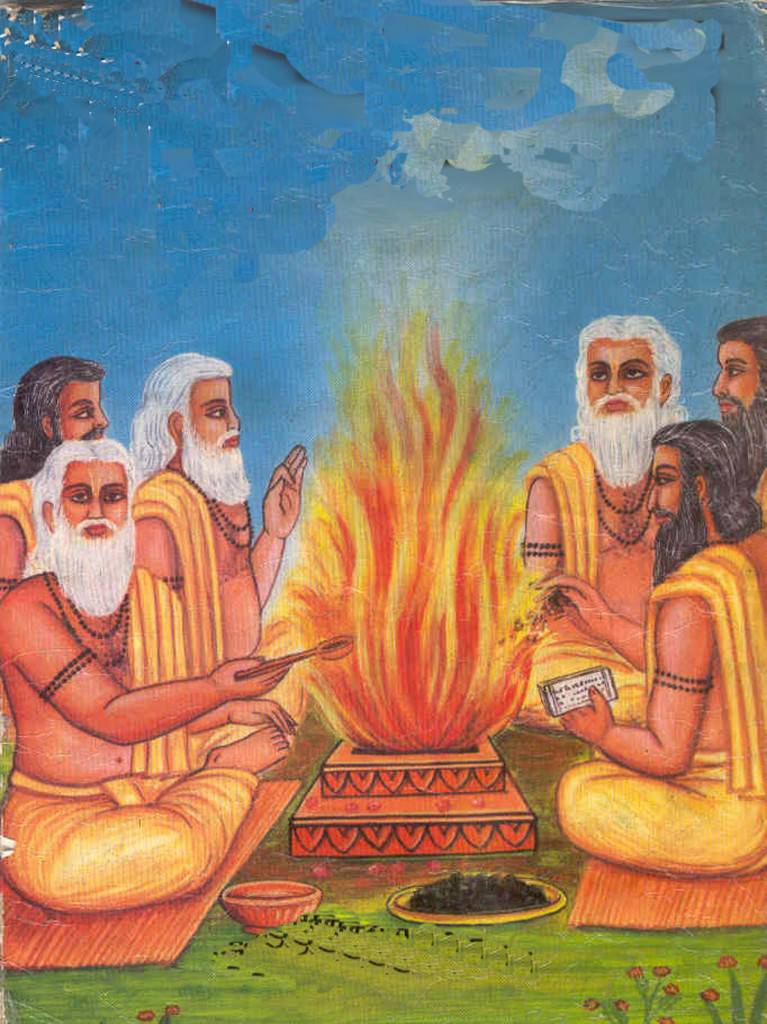- Visitor:158
- Published on:
Agni Vidya: A Kindling of Inner Fire
What is the inner ritual and how does it involve fire? the story of Nachiketa gives us an answer. Read on to find out.

O’ Death you preside over the Fire that leads to Heaven. (Please) tell me about that to me, who is full of faith. The dwellers of Heaven, attain immorality. This, I seek by the second boon. (Katha Upanishad 1.13)
Here, Naciketa asks for knowledge about a sacrifice – Fire – worship, performance of which leads to heaven, where there is no fear of old age or death. The first boon was regarding the mundane world. Now, the boon is regarding higher, spiritual worlds. Sacrifice – Fire worship, to perform Yajnas, was a spiritual discipline to attain not only power and prosperity here and higher worlds above but also to gather spiritual strength to go beyond all worlds. Yajna – sacrifice is a mystery.
The mystic meanings, the secrets behind the ritual practice became obsolete in time. They have to be revived. Sri Krishna tells the same thing to Arjuna about Yoga in the Gita. “This yoga, I had declared to Vivasvana, Vivasvana taught it to Manu, thus it was handed down for a long time. This yoga by the influx of time is lost. I am again declaring that yoga to you.” (IV/1-3) This happens in all cases. Truths decay and are destroyed in Time. They have to be revived. The Fire has to be kindled again and again.
This knowledge of Fire – agnividya – was pioneered by the Rishis Angira and Atharva. As it decayed in time, it had to be rekindled. This is to infuse more strength and power in the spiritual discipline. This is what Naciketa asks in the second boon. In the third boon, Naciketa asks for the knowledge to go beyond all the worlds – beyond Death to Immortality. Naciketa’s three boons are for the three worlds or states. Prakrta – natural, aprakrta – supernatural and Lokottara– beyond all worlds, natural and supernatural. For natural world, morality, ordinary religious practice is sufficient. For supernatural worlds, higher worlds, spiritual aspiration and discipline is required. More spiritual strength is required. For that special practices, special rituals etc are ordained. Knowledge of arranging various sacrifices. Almost half of Satapatha Brahmana, the largest amongst the Brahmans is full of this knowledge – agnicayana Vidya.
Agnicayana is arranging and kindling of Fire in a specially constructed altar. First, the alter ‘vedi’ is to be constructed. Istaka – bricks are required for constructing the altar. Fire has to be collected (ignited) in the altar. Bricks, altar and collecting or kindling of Fire, for every action, there is a ritual. Everything used in the sacrifice has a sacred mystic meaning. Istaka – is a brick made of earth, but its meaning is wish, desire; the word coming from the root ‘is’ to wish, to desire Vedi – the altar – is a specially built fire-place for the sacrifice.
The mystic meaning of the word is thirst for knowledge. Desire of knowledge or the knower is Vedi from the root ‘vid’ to know, to understand, to learn etc. agni – is Fire. Its mystic meaning is the flame of aspiration within us, which always rises above. ‘Agni’ is derived from root ‘aj’ to go, to lead, to rise above, i.e. aspiration for higher knowledge, higher states of consciousness ‘Agnicayana’ means to gather, to collect in the altar all the fire that is dispersed all to gather, to collect in the altar all the fire that is dispersed all around. Body is an altar. Heart is the place of fire. One has to kindle fire in the heart. The flame of fire will rise up to the head center through the susumna nerve.
The altar was to be constructed in the form in a bird, generally a hawk or a swan. A bird is the symbol for the soul – self – Jivatma. It is said in the Brahmans that a hawk brought Soma – the elixir from the solar world. Hawk is the symbol for fast movement, the symbol of speedy movement of the aspiration, emotion of the heart. The swan swims easily in water. Sun is the swan of sky. The sky is like the blue ocean. The sun-swan moves with ease in the blue sky. In sadhana these qualities, speed and easiness are necessary. Our consciousness, our spirit will fly like a hawk. Sri Ramakrishna used to say, “do Sadhana like a dacoit!” Stubbornness is necessary in Sadhana. Passivity, listlessness, languor is a great obstacle in the way. Hawk is a symbol of strength, valor. Strong aspiration, speedy movement does not mean restlessness, fidgeting, anxiety, impatience or worrying. On one side there should be strong and speedy aspiration on the other there should be easiness, effortlessness, absence of stress and strain. This comes from strong faith – Sraddha, “tapah-sraddhe ye hi upavasanti aranye” (Mundaka 1/2/11) – Those who stay in the forest (place of the spiritual discipline) with Faith and Austerity, that attain success in Sadhana.
There should be the feeling of easiness, gladness and yet vigor, and valor is invoked. Kathopanisad also says “Yasya brahma ca ksatram ca ubhe bhavata odanam, mrtyur yasya upasecanam” (1/2/25) – for whom both knowledge (brahma) and strength – valor (Ksatra) are like food and death (mrtyu) is like an ingredient. The food for sadhana will be ‘brahma’ and kstara’. ‘Brahma’ – is knowledge, faith – Sraddha, the peace that knowledge brings (prasanti), go – meaning both cow and the light and ‘Ksatra’ – is strength, heroism, austerity (tapah) asva – meaning both horse and speedy movement. Indra – the Vedic god was therefore called both ‘gavesaka’ – the researcher, the path-finder and ‘asvajita’ the speedy winner, He was invoked for light and strength. Death – mrtyu – discontinuity – rest, sense of void too is required as curry or chatni – ‘Upasecana’. Sometimes one has to remain totally vacant. This is like ‘savasana’- posture of a dead body in the exercises of Asana and Pranayama.
The gladness and ease resulting from knowledge (brahma); the strength and vigor (ksatra) and voidness – silence (sunyata) all the three are very necessary in the spiritual discipline.
We have said before that the altar – Vedi – was constructed in the form of a bird-hawk or swan. Our body is an altar. It is like a bird. In the Taittiriya-Upanisad the body is compared to a swan. All the desires, wishes, longings are like the bricks. In all of these, there is fire. All of that has to be gathered, collected in the heart, in the middle center of the bird – the body. There, the real fire will burn.
Yama teaches a new peculiar form of this knowledge of Fire. It will be named after Naciketa, because the knowledge is revived for and because of Naciketa. New Rishis revive and take forward the knowledge of the ancient Rishis. There is no destruction but reconstruction. It brings about greater fulfilment amongst people.
[Source: Kathoupanishad – Anirvan. New Delhi: Akshay Prakashan, pp. 48-51 ]
Center for Indic Studies is now on Telegram. For regular updates on Indic Varta, Indic Talks and Indic Courses at CIS, please subscribe to our telegram channel !
- 79 min read
- 1
- 0








 - Updated (1).jpg)

